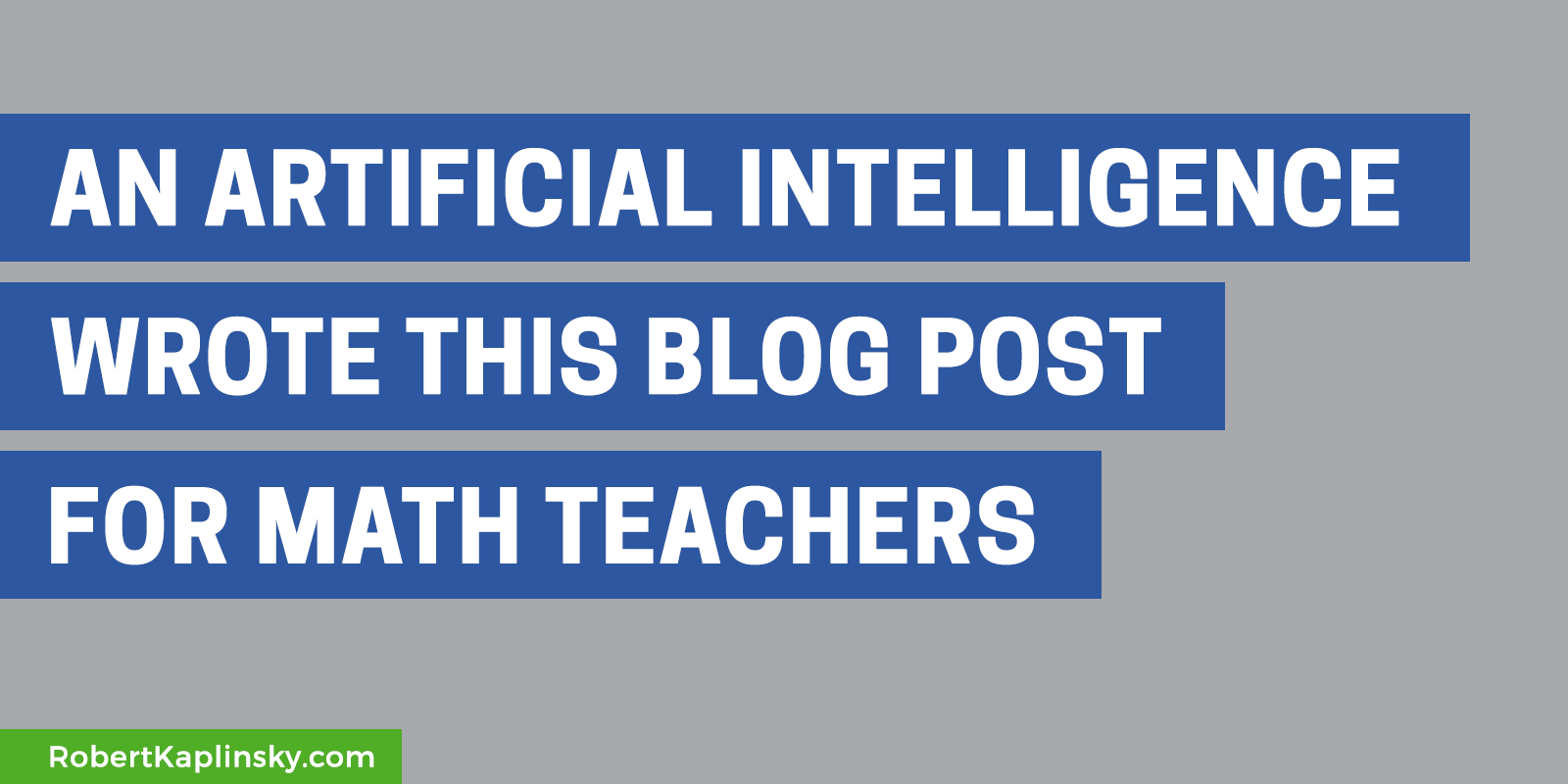I am deeply fascinated by the leaps that artificial intelligence has made in the last few years. When I studied artificial intelligence at UCLA in the late 1990s, chat bots were about as sophisticated as AI got. Nowadays, it can make nearly unfathomable things.


For this artificial intelligence, it requires you to began by writing the initial text. So, I wrote the very first sentence as “Here are five tips for math teachers who want to engage their students.” Then I pressed the “Generate Text” button and it would pump out the next 100 characters or so. I kept pressing it until it had generated the rest of the article.
It immediately started with “1. Get creative.” and I thought that was a promising beginning. What followed was both amazing, bewildering, and terrifying and I think we all need to be aware of the possibilities.
Here are five tips for math teachers who want to engage their students.
1. Get creative.
You can help students learn math by being creative with what you show them. If they’re not engaged, they’re not learning anything.
Think about giving students a coloring page or construction paper to decorate. These assignments are familiar, creative and allow your students to become truly engaged with what they’re learning.
2. Come up with a math problem to do together.
Many times, learning math can be a group activity. Take students on a scavenger hunt. They’ll be learning math through problem solving and to have a fun time as well.
3. Pick a different question each week.
Many classroom teachers forget that different situations call for different ways to approach a problem. Don’t limit your students to math problem that are the same for everyone. They’ll be learning in different ways and different ways to problem solve. If your students aren’t able to come up with different ways to approach problems, then they’re probably not truly engaged.
4. Work on a sense of completion.
Once students are able to “get” a math concept, it’s important that they be able to say that they’ve mastered it. For instance, you might try having your students solve a series of math problems, giving them an opportunity to talk about their process as they solve each problem.
5. Develop a math game.
It doesn’t have to be complicated or high-tech. It can be just a game that you’ve made up. A few examples of how to do this are called the rock, paper, scissors game, mirror, three-card Monte or even a head-to-head race.
When all of the kinks are worked out, you’ll have a great way to engage your students in math and keep them learning the subject.
Kristi Hudson, Ed.D., is a retired North Carolina public school teacher. She is a former professional chess and dice player and is the author of the book “How To Win at Chess.” She lives in Asheville, North Carolina.
After it had written the line near the end “When all of the kinks are worked out, you’ll have a great way to engage your students in math and keep them learning the subject.”, I was done. But then I wondered what would happen if I generated more text. That was when it blew my mind. It gave the name of the person it plagiarized the entire article from! This all made sense because I was wondering where it was getting all these ideas from. So I started looking for the author and the source material.
There will likely be lots of positive uses for this. While I am not a fan of word problems, I realize that they are still going to be around for a while. Imagine one day students enter their interests into a form and then AIs generate word problems that are customized for each student. I don’t know if that is amazing or terrifying just yet, but we need to be aware of what’s on the horizon.
What do you think? Let me know in the comments.


It’s extraordinary that AI can write articles at all. From a content perspective, though, this is quite an unimpressive list. It feels like a bouillabaisse of flat advice and platitudes (“They’ll be learning math through problem solving and to have a fun time as well). If you were to average out all the math articles on the internet, this seems like an approximation of what you might get.
Hilarious that an author was invented for it. I suppose these articles must feature authors names more often than not.
For the time being, I feel confident that my capacity as a writer of math educational content is safe from AI.
Yes, I had very similar takeaways in that it was shocking that it could even make a passable piece of text. The content still has a ways to go, but the speed at which it’s getting better is truly awesome. Put another way, it’s easy for lots of people reading one blog post to know something is not right, but we’re already at the point where one professor scanning (not truly reading) lots of assignments, does not even notice.
Yes, the author part really caught me off guard. I did not want to believe she was faked too because the alternative was more than I was ready for.
From a teacher’s perspective, grading essays and trying to discern what is student work and what isn’t seems baffling. We’re entering a new world, and exactly what the rules will be are still TBD. I didn’t think I’d see this level of writing capacity from computers until much, much later in my life.
I wonder if the author’s identity was a compilation of authors in mathematics education. My logic brain is really trying to work this out
A friend who owns a transcription service asked AI who owned her company and what it told her was an outright lie and when she pointed it out the response was denial (hmmm sounds familiar). I’m concerned that already struggling students will not be able to write at all because they become dependent upon someone or thing to do it for them!
It’s going to be a wild ride.
There are some interesting questions in this piece about what artificial intelligence can do, especially when it comes to making content. The fact that the author looked into AI-generated text, especially a blog post with maths teacher tips, shows how smart these systems are getting.
Wow, what a fascinating read! It’s incredible how far AI has come since the 1990s. The example you shared with Dall-E 2 is mind-blowing.
Regarding your reflections on AI’s capabilities in education, I completely agree that we’re on the brink of some significant changes. It’s interesting that you mentioned AI creating personalized content for students – I think we’re already seeing a glimpse of this with tools like Brisk Teaching. It’s a free Chrome extension that helps teachers save time on lesson planning, utilizing AI to streamline the process.
I share your mixed feelings about the implications, but it’s definitely a space to watch. Thanks for sharing your insights!